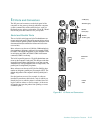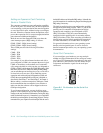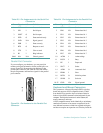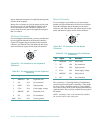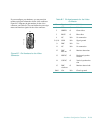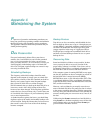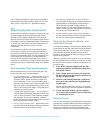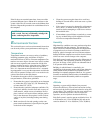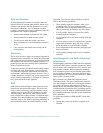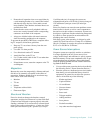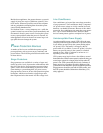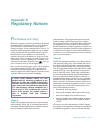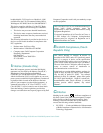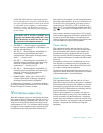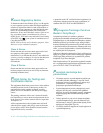
Maintaining the System C-133
If the kit does not contain instructions, insert one of the
pretreated diskettes into a diskette drive and turn on the
system. After 20 or 30 seconds, remove the diskette from
the drive. Repeat this procedure for each diskette drive in
the computer.
Environmental Factors
This section discusses various environmental factors that
can adversely affect system performance and longevity.
Temperature
Temperature extremes can cause a variety of problems,
including premature aging and failure of chips or
mechanical failure of devices. Extreme temperature fluc-
tuations can cause chips to become loose in their sockets
and can cause expansion and contraction of disk drive
platters, resulting in read or write data errors. When you
perform a low-level format operation on a hard-disk
drive, it is important to ensure that the drive’s surround-
ing temperature is at or near the temperature at which the
drive will be operated. Failure to do so can result in relo-
cation of the tracks on the disk platters.
To minimize the negative effects of temperature on sys-
tem performance, follow these guidelines:
• Ensure that the system is operated in an environment
no colder than 10° Celsius (C) (50° Fahrenheit [F])
or hotter than 35°C (95°F).
• Ensure that the system has adequate ventilation. Do
not place it within a closed-in wall unit or on top of
cloth material, which can act as insulation. Do not
place it where it will receive direct sunlight, particu-
larly in the afternoon. Do not place it next to a heat
source of any kind, including heating vents during
winter.
• Make sure that all slots and openings on the com-
puter remain unobstructed, especially the fan guard
on the back of the computer.
• Clean the system at regular intervals to avoid any
buildup of dust and debris, which can cause a system
to overheat.
• If the system is exposed to abnormally cold tempera-
tures, allow a 15-minute warm-up period after it is
turned on before attempting to read from or write to
the hard-disk drive.
• If intermittent system failures are noticed, try reseat-
ing any socketed chips, which might have become
loose due to temperature fluctuations.
Humidity
High-humidity conditions can cause moisture migration
and penetration into the computer. This moisture can
cause corrosion of internal components and degradation
of properties such as electrical resistance, thermal con-
ductivity, physical strength, and size. Extreme moisture
buildup inside the computer can result in electrical shorts,
which can cause serious damage to the computer.
Each Dell system is rated to operate at 8 to 80 percent rel-
ative humidity, with a humidity gradation of 10 percent
per hour. In storage, a Dell system can withstand from 8
to 95 percent relative humidity.
Buildings in which climate is controlled by air-
conditioning in the warmer months and by heat during the
colder months usually maintain an acceptable level of
humidity for computer equipment. However, if a system is
located in an unusually humid location, a dehumidifier can
be used to maintain the humidity within an acceptable
range.
Altitude
Operating a system at high altitude (low pressure)
reduces the efficiency of forced and convection cooling
and can result in electrical problems related to arcing and
corona effects. This condition can also cause sealed com-
ponents with internal pressure, such as electrolytic
capacitors, to fail or perform at reduced efficiency.
Each Dell system is rated to operate at altitudes from -16
to 3048 meters (m) (-50 to 10,000 feet [ft]) and can be
stored at altitudes of -16 to 10,600 m (-50 to 35,000 ft).
CAUTION: Do not attempt to clean drive heads
with a swab. You may accidentally misalign the
heads, rendering the drive inoperable.



